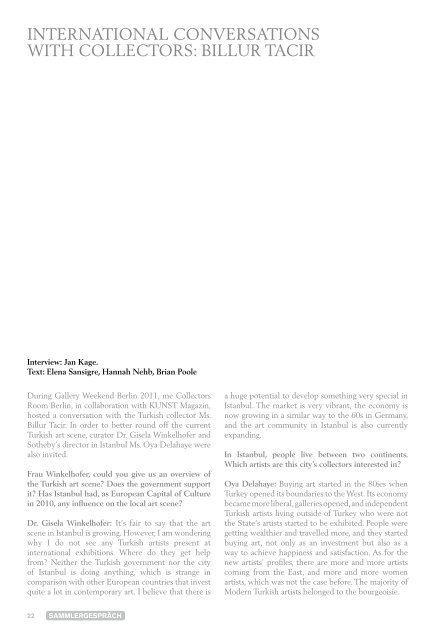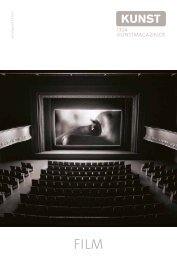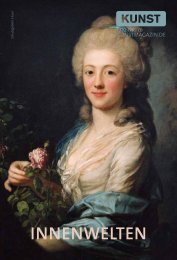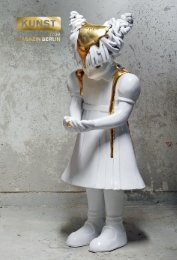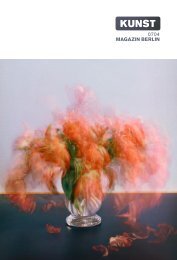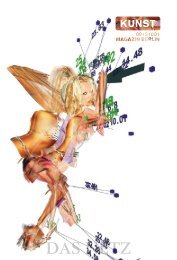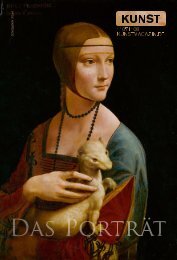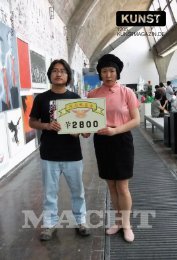KUNST für das iPad - KUNST Magazin
KUNST für das iPad - KUNST Magazin
KUNST für das iPad - KUNST Magazin
Sie wollen auch ein ePaper? Erhöhen Sie die Reichweite Ihrer Titel.
YUMPU macht aus Druck-PDFs automatisch weboptimierte ePaper, die Google liebt.
INTERNATIONAL CONVERSATIONS<br />
WITH COLLECTORS: BILLUR TACIR<br />
Interview: Jan Kage.<br />
Text: Elena Sansigre, Hannah Nehb, Brian Poole<br />
During Gallery Weekend Berlin 2011, me Collectors<br />
Room Berlin, in collaboration with <strong>KUNST</strong> <strong>Magazin</strong>,<br />
hosted a conversation with the Turkish collector Ms.<br />
Billur Tacir. In order to better round off the current<br />
Turkish art scene, curator Dr. Gisela Winkelhofer and<br />
Sotheby’s director in Istanbul Ms. Oya Delahaye were<br />
also invited.<br />
Frau Winkelhofer, could you give us an overview of<br />
the Turkish art scene? Does the government support<br />
it? Has Istanbul had, as European Capital of Culture<br />
in 2010, any influence on the local art scene?<br />
Dr. Gisela Winkelhofer: It’s fair to say that the art<br />
scene in Istanbul is growing. However, I am wondering<br />
why I do not see any Turkish artists present at<br />
international exhibitions. Where do they get help<br />
from? Neither the Turkish government nor the city<br />
of Istanbul is doing anything, which is strange in<br />
comparison with other European countries that invest<br />
quite a lot in contemporary art. I believe that there is<br />
a huge potential to develop something very special in<br />
Istanbul. The market is very vibrant, the economy is<br />
now growing in a similar way to the 60s in Germany,<br />
and the art community in Istanbul is also currently<br />
expanding.<br />
In Istanbul, people live between two continents.<br />
Which artists are this city’s collectors interested in?<br />
Oya Delahaye: Buying art started in the 80ies when<br />
Turkey opened its boundaries to the West. Its economy<br />
became more liberal, galleries opened, and independent<br />
Turkish artists living outside of Turkey who were not<br />
the State’s artists started to be exhibited. People were<br />
getting wealthier and travelled more, and they started<br />
buying art, not only as an investment but also as a<br />
way to achieve happiness and satisfaction. As for the<br />
new artists’ profiles, there are more and more artists<br />
coming from the East, and more and more women<br />
artists, which was not the case before. The majority of<br />
Modern Turkish artists belonged to the bourgeoisie.<br />
Im April wurde Taner Ceylans Arbeit “1879” (2010) bei Sotheby´s in London <strong>für</strong> 229.250 Pfund versteigert.<br />
Couresy: GALERIST, Istanbul<br />
How do the Turkish artists view themselves: as a part<br />
of a global art discourse? Or are they anchored to<br />
the Turkish past, more related to calligraphies or the<br />
Islamic ban on painting?<br />
Oya Delahaye: No. Actually the Turkish artists are<br />
more intrigued by the West. That doesn’t mean they<br />
are trying to break with their Eastern traditions.<br />
Turks—and this started with the Ottomans—have<br />
always moved and have always been attracted to the<br />
West, to Europe.<br />
Ms. Tacir, you studied in Pennsylvania. Actually you<br />
bought your first piece of art there. Was it American<br />
art? What made you continue collecting art?<br />
Billur Tacir: My interest in contemporary art did<br />
start at the Wharton Business School in Philadelphia,<br />
where I took a course on American contemporary art.<br />
I was really fascinated by the abstract expressionists<br />
and the pop artists. At that time I couldn’t afford to<br />
buy abstract expressionism, so the first piece I bought<br />
was an Andy Warhol print. I was really excited about<br />
owning a part of art history, owning a work from an<br />
artist I really admire. From then on, I spent every<br />
weekend in museums and galleries. My passion grew<br />
when I met my husband Atilla, who also shares this<br />
passion.<br />
What have you been collecting since you arrived<br />
back in Istanbul? Are you now more into young<br />
Turkish art? Are there any trends that you like?<br />
Billur Tacir: To be honest, my taste has been changing<br />
also because there has been such a development in<br />
Turkish art with a more Western approach. When<br />
I first came to Turkey, there was a greater focus on<br />
tradition. But the younger generation of artists are<br />
much more open to the West. It is really exciting<br />
to see how they are working with lots of different<br />
media.<br />
SAMMLERGESPRÄCH SAMMLERGESPRÄCH


